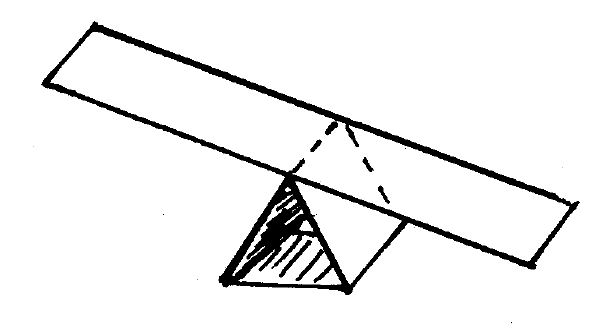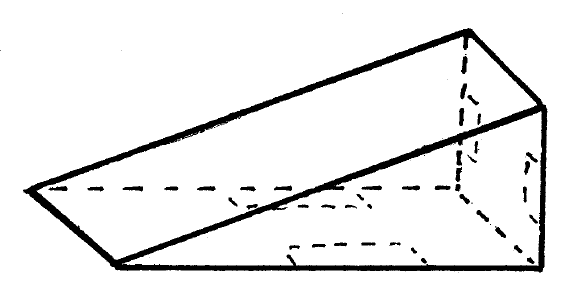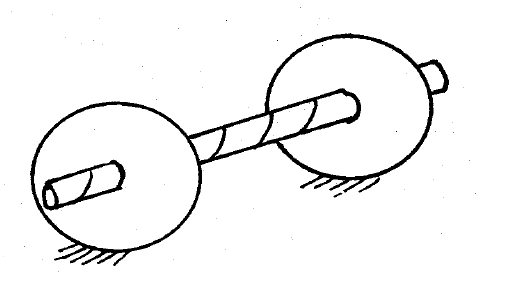Six Kinds Do It All
Students investigate six kinds of simple machines—inclined plane, pulley, screw, wedge, lever, and wheel and axle, and determine that simple machines can be combined to form complex machines.
Background
Lesson Activities
Recommended Companion Resources
Credits
Author
Tonja Cargill and Pamela Emery | California Foundation for Agriculture in the Classroom
Acknowledgements
This lesson was funded in 1996 by the California Beef Council and the California Farm Bureau Federation. To meet the needs of California educators, Simple and Complex Machines Used in Agriculture was revised to support the Curriculum Content Standards for California Public Schools and updated to include recent agricultural innovations. Funding from the Wells Fargo Foundation made this revision possible.
Illustrators: Karin Bakotich, Pat Houk, Sherri Hughes, Regina Johnson
Layout and Design: Nina Danner
Standards
Texas Content Area Standards
-
ELA: 4.110.6.b.1
Developing and sustaining foundational language skills: listening, speaking, discussion, and thinking- oral language. The students develops oral language through listening, speaking, and discussion.
- ELA: 4.110.6.b.1.D: work collaboratively with others to develop a plan of shared responsibilities
-
Social Studies: 3.113.14.c.4
Geography. The student understands the concepts of location, distance, and direction on maps and globes. The student is expected to:
- Social Studies: 3.113.14.c.14.D: interpret and create visuals, including graphs, charts, tables, timelines, illustrations, and maps
-
Social Studies: 3.113.14.c.15
Social studies skills. The student communicates in written, oral, and visual forms. The student is expected to:
- Social Studies: 3.113.14.c.15.D: express ideas orally based on knowledge and experiences
-
Social Studies: 3.113.14.c.16
Social studies skills. The student uses problem-solving and decision-making skills, working independently and with others. The student is expected to:
- Social Studies: 3.113.14.c.16.B: use problem-solving and decision-making processes to identify a problem, gather information, list and consider options, consider advantages and disadvantages, choose and implement a solution, and evaluate the effectiveness of the solution
-
Social Studies: 4.113.15.c.21
Social studies skills. The student communicates in written, oral, and visual forms. The student is expected to:
- Social Studies: 4.113.15.c.21.C: express ideas orally based on research and experiences
- Social Studies: 4.113.15.c.21.D: create written and visual material such as journal entries, reports, graphic organizers, outlines, and bibliographies
-
Social Studies: 4.113.15.c.22
Social studies skills. The student uses problem-solving and decision-making skills, working independently and with others. The student is expected to:
- Social Studies: 4.113.15.c.22.B: use problem-solving and decision-making processes to identify a problem, gather information, list and consider options, consider advantages and disadvantages, choose and implement a solution, and evaluate the effectiveness of the solution
-
Social Studies: 5.113.16.c.25
Social studies skills. The student communicates in written, oral, and visual forms. The student is expected to:
- Social Studies: 5.113.16.c.25.C: express ideas orally based on research and experiences
- Social Studies: 5.113.16.c.25.D: create written and visual material such as journal entries, reports, graphic organizers, outlines, and bibliographies
-
Social Studies: 5.113.16.c.26
Social studies skills. The student uses problem-solving and decision-making skills, working independently and with others. The student is expected to:
- Social Studies: 5.113.16.c.26.B: use problem-solving and decision-making processes to identify a problem, gather information, list and consider options, consider advantages and disadvantages, choose and implement a solution, and evaluate the effectiveness of the solution
-
Science: 3.112.5.b.1
Scientific and engineering practices. The student asks questions, identifies problems, and plans and safely conducts classroom, laboratory, and field investigations to answer questions, explain phenomena, or design solutions using appropriate tools and models. The student is expected to:
- Science: 3.112.5.b.1.B: use scientific practices to plan and conduct descriptive investigations and use engineering practices to design solutions to problems
- Science: 3.112.5.b.1.D: use tools, including hand lenses; metric rulers; Celsius thermometers; wind vanes; rain gauges; graduated cylinders; beakers; digital scales; hot plates; meter sticks; magnets; notebooks; Sun, Earth, Moon system models; timing devices; materials to support observation of habitats of organisms such as terrariums, aquariums, and collecting nets; and materials to support digital data collection such as computers, tablets, and cameras, to observe, measure, test, and analyze information
- Science: 3.112.5.b.1.E: collect observations and measurements as evidence
- Science: 3.112.5.b.1.F: construct appropriate graphic organizers to collect data, including tables, bar graphs, line graphs, tree maps, concept maps, Venn diagrams, flow charts or sequence maps, and input-output tables that show cause and effect
- Science: 3.112.5.b.1.G: develop and use models to represent phenomena, objects, and processes or design a prototype for a solution to a problem
-
Science: 3.112.5.b.2
Scientific and engineering practices. The student analyzes and interprets data to derive meaning, identify features and patterns, and discover relationships or correlations to develop evidence-based arguments or evaluate designs. The student is expected to:
- Science: 3.112.5.b.2.C: use mathematical calculations to compare patterns and relationships
-
Science: 3.112.5.b.3
Scientific and engineering practices. The student develops evidence-based explanations and communicates findings, conclusions, and proposed solutions. The student is expected to:
- Science: 3.112.5.b.3.A: develop explanations and propose solutions supported by data and models
-
Science: 3.112.5.b.5
Recurring themes and concepts. The student understands that recurring themes and concepts provide a framework for making connections across disciplines. The student is expected to:
- Science: 3.112.5.b.5.A: identify and use patterns to explain scientific phenomena or to design solutions
- Science: 3.112.5.b.5.B: identify and investigate cause-and-effect relationships to explain scientific phenomena or analyze problems
- Science: 3.112.5.b.5.C: use scale, proportion, and quantity to describe, compare, or model different systems
- Science: 3.112.5.b.5.D: examine and model the parts of a system and their interdependence in the function of the system
-
Science: 3.112.5.b.7
Force, motion, and energy. The student knows the nature of forces and the patterns of their interactions. The student is expected to:
- Science: 3.112.5.b.7.A: demonstrate and describe forces acting on an object in contact or at a distance, including magnetism, gravity, and pushes and pulls
- Science: 3.112.5.b.7.B: plan and conduct a descriptive investigation to demonstrate and explain how position and motion can be changed by pushing and pulling objects such as swings, balls, and wagons
-
Science: 3.112.5.b.8
Force, motion, and energy. The student knows that energy is everywhere and can be observed in cycles, patterns, and systems. The student is expected to:
- Science: 3.112.5.b.8.B: plan and conduct investigations that demonstrate how the speed of an object is related to its mechanical energy
-
Science: 4.112.6.b.1
Scientific and engineering practices. The student asks questions, identifies problems, and plans and safely conducts classroom, laboratory, and field investigations to answer questions, explain phenomena, or design solutions using appropriate tools and models. The student is expected to:
- Science: 4.112.6.b.1.B: use scientific practices to plan and conduct descriptive investigations and use engineering practices to design solutions to problems
- Science: 4.112.6.b.1.D: use tools, including hand lenses; metric rulers; Celsius thermometers; calculators; laser pointers; mirrors; digital scales; balances; graduated cylinders; beakers; hot plates; meter sticks; magnets; notebooks; timing devices; sieves; materials for building circuits; materials to support observation of habitats of organisms such as terrariums, aquariums, and collecting nets; and materials to support digital data collection such as computers, tablets, and cameras, to observe, measure, test, and analyze information
- Science: 4.112.6.b.1.E: collect observations and measurements as evidence
- Science: 4.112.6.b.1.F: construct appropriate graphic organizers to collect data, including tables, bar graphs, line graphs, tree maps, concept maps, Venn diagrams, flow charts or sequence maps, and input-output tables that show cause and effect
- Science: 4.112.6.b.1.G: develop and use models to represent phenomena, objects, and processes or design a prototype for a solution to a problem
-
Science: 4.112.6.b.2
Scientific and engineering practices. The student analyzes and interprets data to derive meaning, identify features and patterns, and discover relationships or correlations to develop evidence-based arguments or evaluate designs. The student is expected to:
- Science: 4.112.6.b.2.C: use mathematical calculations to compare patterns and relationships
-
Science: 4.112.6.b.3
Scientific and engineering practices. The student develops evidence-based explanations and communicates findings, conclusions, and proposed solutions. The student is expected to:
- Science: 4.112.6.b.3.A: develop explanations and propose solutions supported by data and models
-
Science: 4.112.6.b.5
Recurring themes and concepts. The student understands that recurring themes and concepts provide a framework for making connections across disciplines. The student is expected to:
- Science: 4.112.6.b.5.A: identify and use patterns to explain scientific phenomena or to design solutions
- Science: 4.112.6.b.5.B: identify and investigate cause-and-effect relationships to explain scientific phenomena or analyze problems
- Science: 4.112.6.b.5.C: use scale, proportion, and quantity to describe, compare, or model different systems
- Science: 4.112.6.b.5.D: examine and model the parts of a system and their interdependence in the function of the system
-
Science: 4.112.6.b.7
Force, motion, and energy. The student knows the nature of forces and the patterns of their interactions. The student is expected to plan and conduct descriptive investigations to explore the patterns of forces such as gravity, friction, or magnetism in contact or at a distance on an object.
- Science: 4.112.6.b.7: Force, motion, and energy. The student knows the nature of forces and the patterns of their interactions. The student is expected to plan and conduct descriptive investigations to explore the patterns of forces such as gravity, friction, or magnetism in contact or at a distance on an object.
-
Science: 5.112.7.b.1
Scientific and engineering practices. The student asks questions, identifies problems, and plans and safely conducts classroom, laboratory, and field investigations to answer questions, explain phenomena, or design solutions using appropriate tools and models. The student is expected to:
- Science: 5.112.7.b.1.B: use scientific practices to plan and conduct descriptive investigations and use engineering practices to design solutions to problems
- Science: 5.112.7.b.1.D: use tools, including calculators, microscopes, hand lenses, metric rulers, Celsius thermometers, prisms, concave and convex lenses, laser pointers, mirrors, digital scales, balances, spring scales, graduated cylinders, beakers, hot plates, meter sticks, magnets, collecting nets, notebooks, timing devices, materials for building circuits, materials to support observations of habitats or organisms such as terrariums and aquariums, and materials to support digital data collection such as computers, tablets, and cameras to observe, measure, test, and analyze information
- Science: 5.112.7.b.1.E: collect observations and measurements as evidence
- Science: 5.112.7.b.1.F: construct appropriate graphic organizers used to collect data, including tables, bar graphs, line graphs, tree maps, concept maps, Venn diagrams, flow charts or sequence maps, and input-output tables that show cause and effect
- Science: 5.112.7.b.1.G: develop and use models to represent phenomena, objects, and processes or design a prototype for a solution to a problem
-
Science: 5.112.7.b.2
Scientific and engineering practices. The student analyzes and interprets data to derive meaning, identify features and patterns, and discover relationships or correlations to develop evidence-based arguments or evaluate designs. The student is expected to:
- Science: 5.112.7.b.2.A: identify advantages and limitations of models such as their size, properties, and materials
- Science: 5.112.7.b.2.C: use mathematical calculations to compare patterns and relationships
-
Science: 5.112.7.b.5
Recurring themes and concepts. The student understands that recurring themes and concepts provide a framework for making connections across disciplines. The student is expected to:
- Science: 5.112.7.b.5.A: identify and use patterns to explain scientific phenomena or to design solutions
- Science: 5.112.7.b.5.B: identify and investigate cause-and-effect relationships to explain scientific phenomena or analyze problems
- Science: 5.112.7.b.5.C: use scale, proportion, and quantity to describe, compare, or model different systems
- Science: 5.112.7.b.5.D: examine and model the parts of a system and their interdependence in the function of the system
-
Science: 5.112.7.b.7
Force, motion, and energy. The student knows the nature of forces and the patterns of their interactions. The student is expected to:
- Science: 5.112.7.b.7.A: investigate and explain how equal and unequal forces acting on an object cause patterns of motion and transfer of energy
- Science: 5.112.7.b.7.B: design a simple experimental investigation that tests the effect of force on an object in a system such as a car on a ramp or a balloon rocket on a string
-
ELA: 3.110.5.b.1
Developing and sustaining foundational language skills: listening, speaking, discussion, and thinking--oral language. The student develops oral language through listening, speaking, and discussion. The student is expected to:
- ELA: 3.110.5.b.1.D: work collaboratively with others by following agreed-upon rules, norms, and protocols
-
ELA: 3.110.5.b.6
Comprehension skills: listening, speaking, reading, writing, and thinking using multiple texts. The student uses metacognitive skills to both develop and deepen comprehension of increasingly complex texts. The student is expected to:
- ELA: 3.110.5.b.6.H: synthesize information to create new understanding
-
ELA: 3.110.5.b.7
Response skills: listening, speaking, reading, writing, and thinking using multiple texts. The student responds to an increasingly challenging variety of sources that are read, heard, or viewed. The student is expected to:
- ELA: 3.110.5.b.7.F: respond using newly acquired vocabulary as appropriate
-
ELA: 4.110.6.b.6
Comprehension skills: listening, speaking, reading, writing, and thinking using multiple texts. The student uses metacognitive skills to both develop and deepen comprehension of increasingly complex texts. The student is expected to:
- ELA: 4.110.6.b.6.H: synthesize information to create new understanding
-
ELA: 4.110.6.b.7
Response skills: listening, speaking, reading, writing, and thinking using multiple texts. The student responds to an increasingly challenging variety of sources that are read, heard, or viewed. The student is expected to:
- ELA: 4.110.6.b.7.F: respond using newly acquired vocabulary as appropriate
-
ELA: 5.110.7.b.1
Developing and sustaining foundational language skills: listening, speaking, discussion, and thinking--oral language. The student develops oral language through listening, speaking, and discussion. The student is expected to:
- ELA: 5.110.7.b.1.D: work collaboratively with others to develop a plan of shared responsibilities
-
ELA: 5.110.7.b.6
Comprehension skills: listening, speaking, reading, writing, and thinking using multiple texts. The student uses metacognitive skills to both develop and deepen comprehension of increasingly complex texts. The student is expected to:
- ELA: 5.110.7.b.6.H: synthesize information to create new understanding
-
ELA: 5.110.7.b.7
Response skills: listening, speaking, reading, writing, and thinking using multiple texts. The student responds to an increasingly challenging variety of sources that are read, heard, or viewed. The student is expected to:
- ELA: 5.110.7.b.7.F: respond using newly acquired vocabulary as appropriate
-
Technology Applications: 126.8.c.1
Computational thinking--foundations. The student explores the core concepts of computational thinking, a set of problem-solving processes that involve decomposition, pattern recognition, abstraction, and algorithms. The student is expected to:
- Technology Applications: 126.8.c.1.C: develop a plan collaboratively and document a plan that outlines specific steps taken to complete a project
-
Technology Applications: 126.9.c.1
Computational thinking--foundations. The student explores the core concepts of computational thinking, a set of problem-solving processes that involve decomposition, pattern recognition, abstraction, and algorithms. The student is expected to:
- Technology Applications: 126.9.c.1.C: communicate design plans and solutions using a variety of options
 Cut out the lever pattern from the
Cut out the lever pattern from the 
 Cut out the inclined plane patterns found in the Simple Machine Templates file. Fold and tape as shown.
Cut out the inclined plane patterns found in the Simple Machine Templates file. Fold and tape as shown. Cut out two wedge patterns found in the Simple Machine Templates.
Cut out two wedge patterns found in the Simple Machine Templates. Cut out the triangle found in the Simple Machine Templates.
Cut out the triangle found in the Simple Machine Templates. Wheel and Axle Activity
Wheel and Axle Activity
 Cut a 1' (30.48 cm) piece of string, and thread it through the middle of a round wooden tinker toy, drapery pulley, thread spool, or bobbin.
Cut a 1' (30.48 cm) piece of string, and thread it through the middle of a round wooden tinker toy, drapery pulley, thread spool, or bobbin.